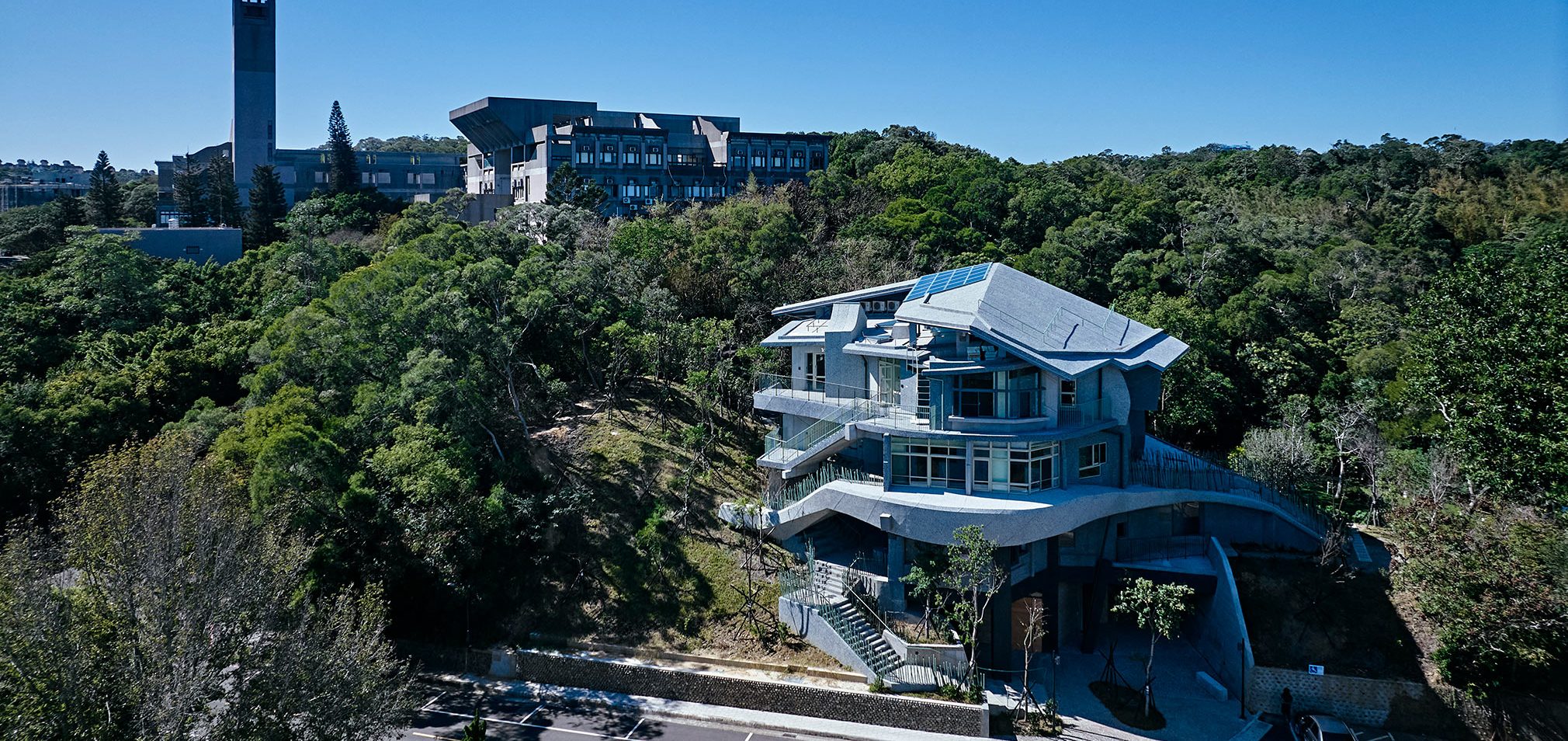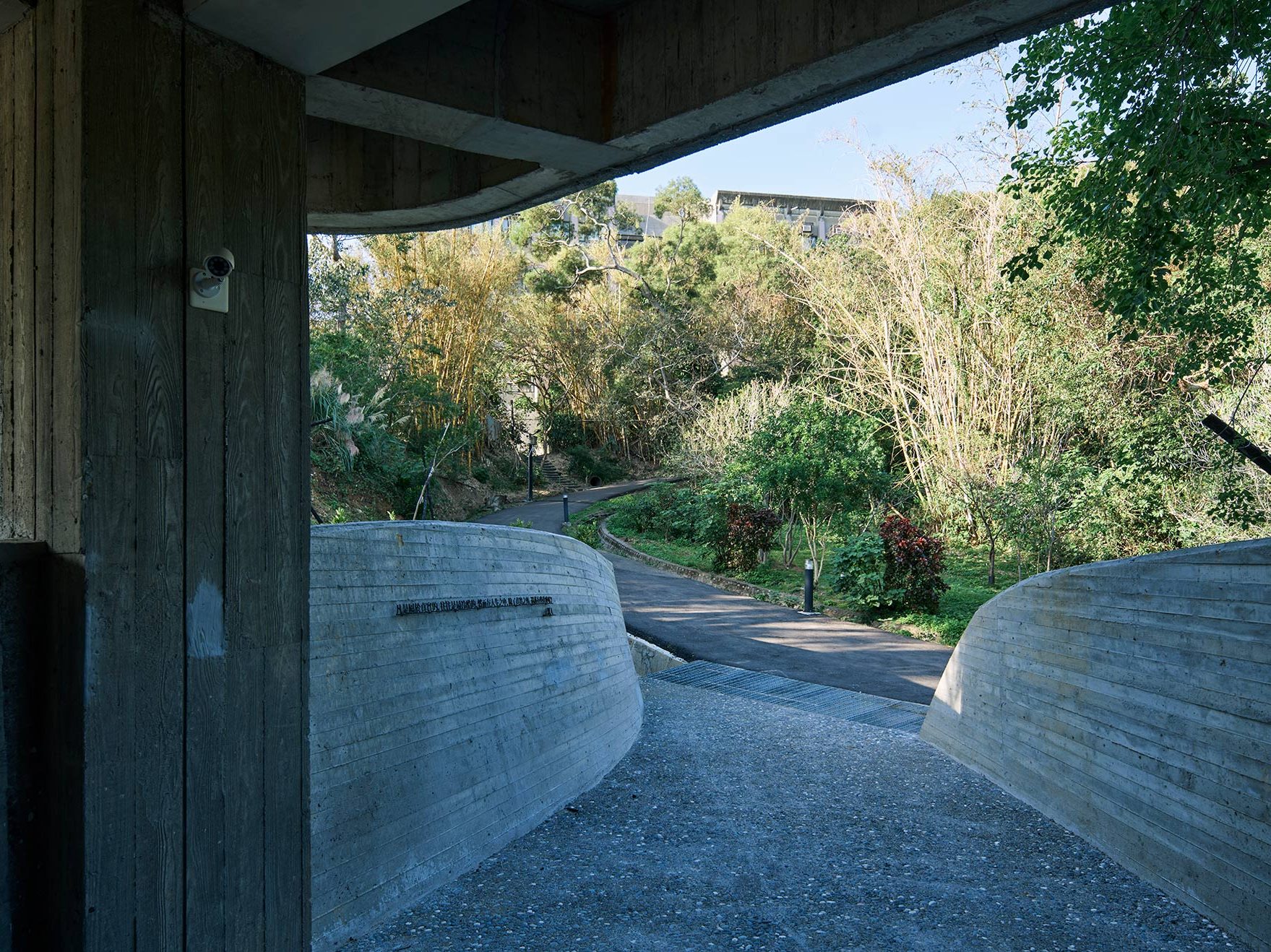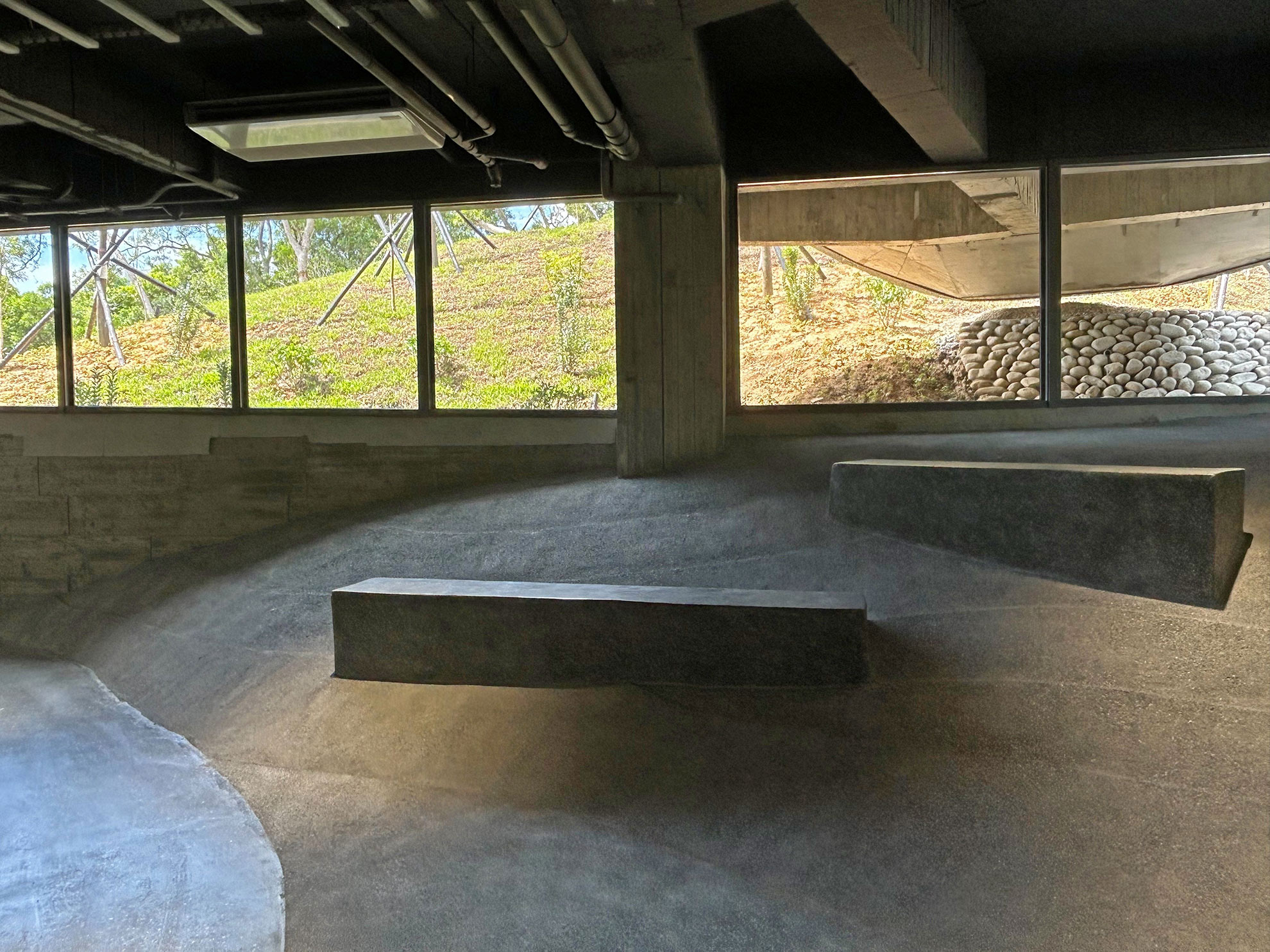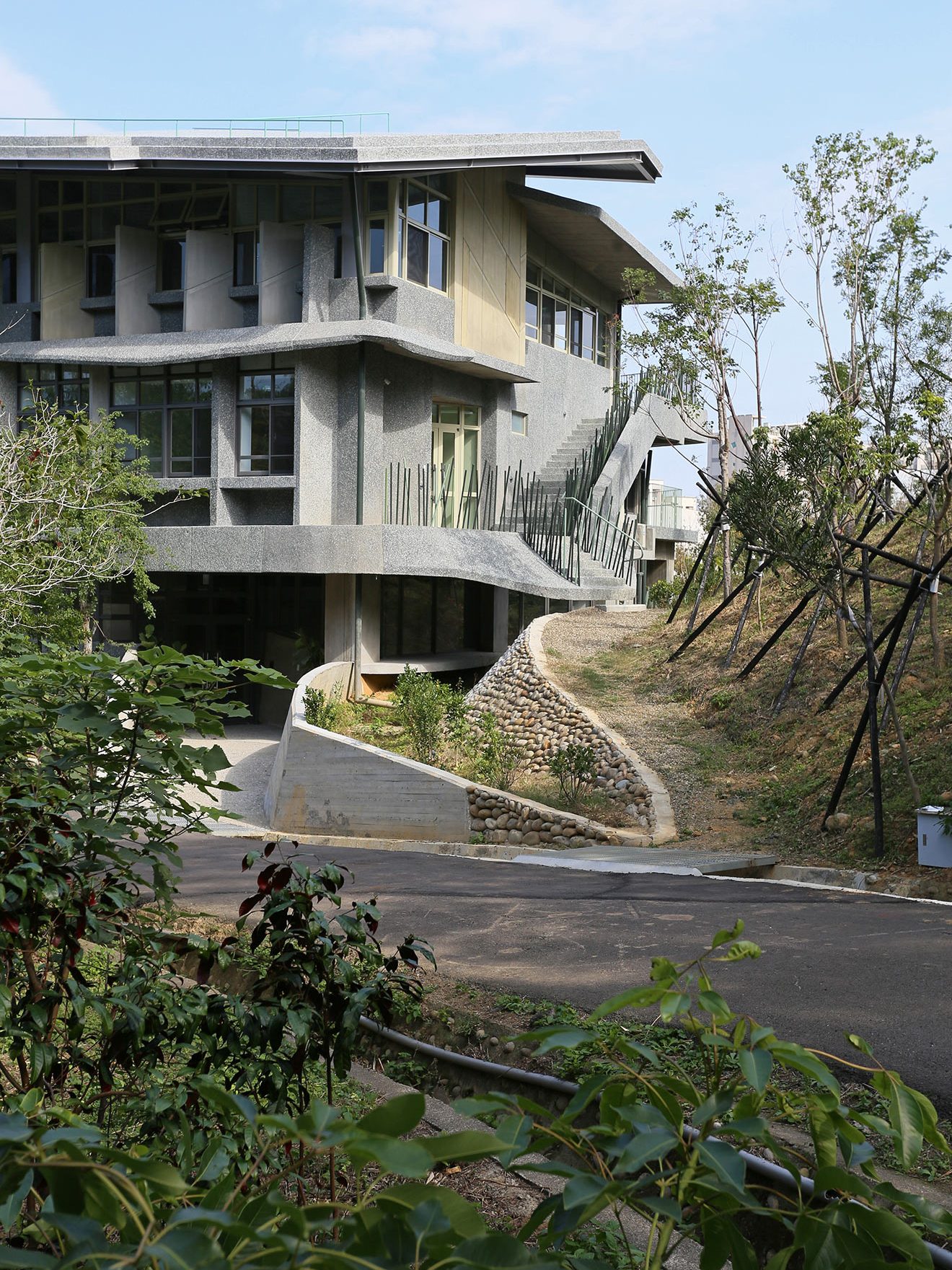河階或沖積扇邊的凸起高地,從史前就令人神往,清華的氣韻生動,相信和校園搭在十八尖山東側、享有足夠留白的連綿丘陵地形有關。在新竹待了這些年,總覺得清大人非常幸運,可以跨越人所定義的紛紛擾擾。
起伏的南北陵線,從最南邊的文物館、經土地公廟、繞著人社院來到梅園,保住了山的層次。特別是梅園和人社院之間秀氣的小山脊,輕輕候住了相思湖的山泉。這鞍部前的一汪湖水就像十八尖山的邀請,等待東邊最青春難忘的宿舍群丘陵翻過或穿過與她銜接。
很懷念三十八年前的畢業設計,曾做過模型想把水切入和平島的山脊,再用小說似的未來空間把鞍部不動聲色的填補回來⋯ 透明如時空的結界。
王默人、周安儀伉儷捐助成立「文學講座」時,秉持的初心即是希望能降低創作門檻、推廣範疇、提高高度,以平易並具有想像力的形式放鬆進入創作世界。
清大文學館選擇不佔用坡前任何一塊平地、更不站在山坡上,而是「嵌入其中」。
如果小山脊算是從文學院直通梅園的「地面」,台文和華文加起來往上兩層高、盡量用纖細的木料定義研究室,屋頂順著原鞍部相思林茂密的天際線,與樹梢齊高。
那麼猶如王默人作品「地層下」深色礦坑的通道和「挖進」山裏「嵌入」的黑盒子實驗劇場,從工科館前大草坪「鑽過」台文所華文所下面,轉彎迎面而來的就是相思湖。等待漸長的植被、絕美的青苔,悠久如大地般低調。數世紀以來文學總是透過劇本的掩護挑戰社會的因循。
等待路邊和山坡上的大樹重新長好,施工暫時露出來的再盡量遮回去。
那時,我們將重新發現這地形的魅力已經有更公共的準備,鑽過各式各樣不受限的文學介面,邀請自發的使用和佔用。靜下來,凝視這努力爭來的四通八達,包容、吸收、重拾清華和十八尖山㩦手可以企及的高度。
而西端的自由車場,相信有朝一日能夠轉身成十八尖山遠眺臺灣海峽和香山海岸的心靈制高點,山下是一連串早該互相牽手的青年培育基地,與汀甫圳一起,灌溉新竹這等待完全甦醒的老城!
Highlands along river terraces and alluvial fan have been enchanting since prehistoric times. I believe that the vibrant charm of National Tsing Hua University (NTHU) is closely tied to its campus location on the eastern side of Eighteen Peaks Mountain, with its waving hills providing ample open spaces. Having lived in Hsinchu for years, I always feel that Tsinghua people are truly fortunate to transcend the chaos defined by human boundaries.
The undulating longitudinal ridge of the mountain connects with the Heritage Museum to the south, passes the Tudigong Shrine, winds around the Humanities and Social Sciences Building, and finally extends to the Mei Garden. The mountain's natural layers are preserved. This is especially true of the delicate mountain ridge between the Mei Garden and the Humanities and Social Sciences Building gently cradling the mountain spring feeding Hsiangsi Lake. This lake is located in front of the mountain saddle and acts as an inviting entry to the Eighteen Peaks Mountain. A cluster of dormitories resembling hills on the eastern edge triggers youth memories, as they seemingly transverse through the mountain connecting back to the lake.
I recall nostalgically my graduation thesis design from 38 years ago. A model was made where water cuts through the mountain ridge of the Heping Island. Then a fictional future space would quietly fill the mountain saddle, as a transparent barrier in time and space.
When Mo-Jen Wang and An-Yi Chou establish the 'Literature Lecture Series,' with a generous donation, their original intention was to lower the bar of entry into the creative process. This will allow for expanding the scope and elevating the quality of literature, making the literary world more accessible through simple and imaginative approaches.
Jie Ying Hall at NTHU chose not to occupy any flat land in front of the slope, nor does it stand on the hillside, but instead, it is ‘embedded within.’
The ridge is considered the ‘ground’ directly connecting the Humanities and Social Sciences Building to Mei Garden. Using delicate wood materials to define the study rooms, Jie Ying Hall raises two stories above the ground, incorporating both Taiwanese and Chinese language departments. The roof tracks the original mountain saddle's dense skyline of acacia trees, rising to the same height as the treetops.
Much like passages in Mo-Jen Wang’s work, Lower Stratum, describing dark mining tunnels, the black box theater was ‘embedded’ into the mountain. It ‘burrows’ underground from the expansive lawn in front of the Engineering and System Science Building. And it connects to the Institute of Taiwan Literature and the Institute of Sinophone Studies. Just around the corner lies the Hsiangsi Lake. The growing vegetation and exquisite moss are as timeless and humble as the earth. For centuries, literature has challenged societal norms under the guise of scripts.
Patiently awaiting the trees to regrow along the roadside and hillside, the temporary scars of construction will gently fade, as nature gracefully reclaims and conceals what was once laid bare.
Then, we shall find the charisma of this landscape taking on a more public dimension, streaming diverse facets of literature and inviting individuals to occupy and engage with it. One would pause and gaze upon this hard-earned connectivity, embracing, absorbing, and reclaiming the heights that Tsing-Hua University and the Eighteen Peaks Mountain can reach together.
As for the free parking lot at the west side, we believe it will one day transform into an observation deck for Eighteen Peaks, offering views of the Taiwan Strait and the Xiangshan coastline. At the foot of the mountains are several campuses that should collaborate to cultivate talents. Together with Tingfuzun, they will irrigate the old city of Hsinchu, which is waiting to fully awaken!
(全文請見《實構築》季刊23期)






